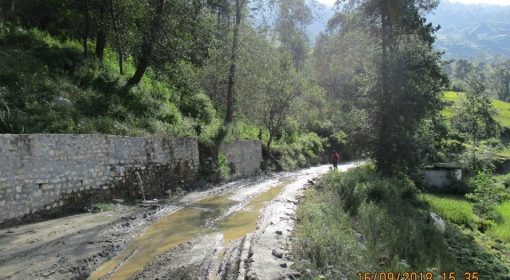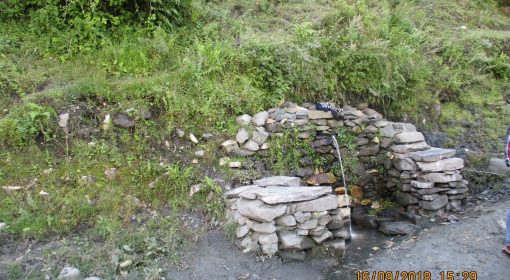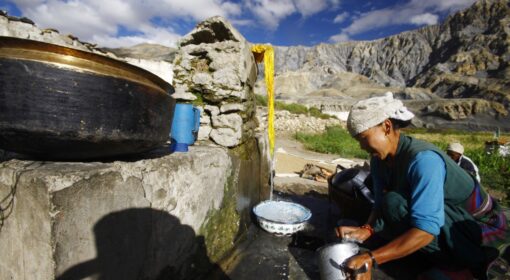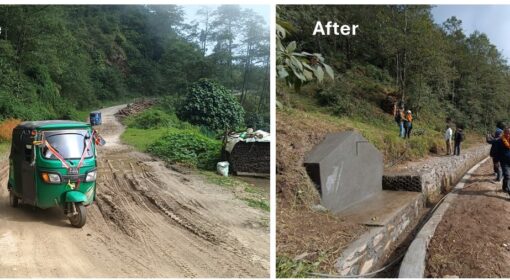By Saroj Yakami
It is a cause of high alarm – springs are drying in high mountain areas and there is no alternative source of water.
The general statement or common story of the villages and communities in the hill and the mountain area of Nepal are “Water started becoming scarce from long time but more severe in the last 3 years or 5 years or 7 years”, “my field are dry that it has developed a crack but there is no water, and the nearest river is at least few hours’ walk away at the bottom of deep valley”.
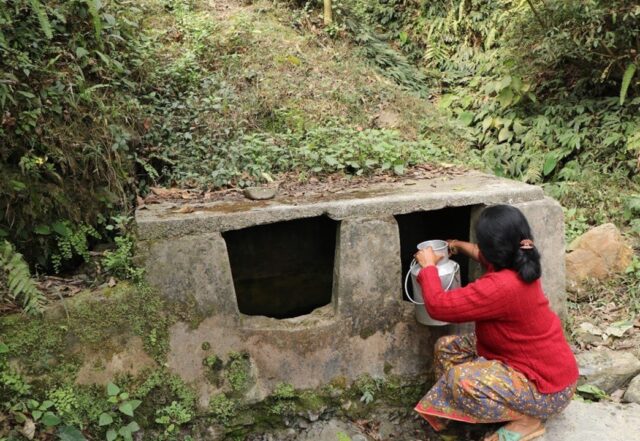
In such a scenario, springs becomes the only lifeline. Springs sources form the backbones of the water supply in hill and mountains of Nepal, and they are the lifeline to many people (for drinking, domestic uses and agricultural need), terrestrial and aquatic ecosystems. The natural springs represent the groundwater storage within the catchments, which form an important component of the Himalayan water budget (Andermann et al. 2012).
Few studies have been made so far by USAID, NWCF, ICIMOD and IWMI on the status of springs in Nepal. The study by NWCF and ICIMOD in 2020 in 300 municipalities in the different parts of Nepal covering Churia, mid-hills and mountain region revealed that springs are drying due to three main factors i.e. anthropogenic activities, climate change and seismic events. The study found that springs are drying up in 74% of the municipalities. According to leaders from local government in 300 municipalities, major causes of drying springs are haphazard road and infrastructure construction as cited by 51% participants, followed by earthquake (46%), climate change (45%), deforestation (32%), landslide (30%) and other causes like hydropower tunnels, forest fires, destruction of old ponds and aahals (wallows) and concertized traditional irrigation channels. The study also found out that drying of springs has different levels of impact on different sectors: 76 percent on drinking water, 36 percent on sanitation and hygiene, 35 percent on livestock feeding, and 50 percent on irrigation and other domestic uses.
Another study made through the support of USAID in five watersheds namely Middle Karnali, Rangum, Jhimruk, Thuligad and Bogtam-Lagam Karnali in the western part of Nepal. A total of 4,222 springs were measured of which 56% were open springs, 15% were ponds, 15% were concrete tanks, 13% were stone spouts and 1% was well. In the Middle Karnali watershed, of 1,960 springs mapped, 71.6% of springs has reduced water discharge, 26.15% has unchanged water flow, 0.65% of the springs were dried up and 1.53% of springs water flow has increased. For others in the table below. In Bogtan-Lagam Karnali (213 springs), Jhimruk (491) and Rangun (1,122) watersheds, water discharge has decreased by approx. 97.78%, 84.56% and 72.59% respectively. In overall, the study revealed that the flow from approx.. 70.07% of springs (of 4,222 springs mapped) has decreased. In some areas, permanent springs have transformed to seasonal while 1.57% of the seasonal springs have dried up. The flow rate in about 26.54% of mapped springs has been unchanged while approx. 1.82% of the mapped springs, flow rate has increased.
Table 1: Status of spring water resources in some key watersheds
| Watershed | No. of Springs mapped | Springs context compared to 20 years (%) | |||
| Decreased | Unchanged | increased | Dried up | ||
| Middle Karnali (fractured springs) | 1,960 (100%) | 71.6 | 26.15 | 1.53 | 0.65 |
| Jhimruk | 491 | 61.22 | 3.05 | ||
| Rangun | 1,122 | 3.44 | 2.07 | ||
| Thuligad | 343 | ||||
| Bogtan-Lagam Karnali | 213 | 98.78 | |||
Despite the importance, the springs across the country’s mid-hills are drying and disappearing, causing distress to people and geographical regions, and forcing some villages to relocate entirely. The water resource in the aquifers is depleting as a result of multiple anthropogenic activities and climate change factors (Tambe et al., 2012). Anthropogenic activities such as haphazard road development, degradation of the catchments, land use changes and erratic rainfall patterns influence by climate change have disrupted the hillslope hydrology and added stress to groundwater reserves in the middle mountains of Nepal (Ghimire et al., 2019), that led to drying up of spring sources and the reduction of regular flow regimes, especially during the dry season (ICIMOD, 2015; Chapagain et al., 2019; Ghimire et al., 2019). The drying of springs signals a much larger problem: a natural system that’s failing. Not only limited to water supply, but springs are also connected with everything: the economy, agricultural production, sanitation, health, and development[1].
[1] https://kathmandupost.com/climate-environment/2019/11/29/once-gushing-with-water-nepal-s-springs-are-rapidly-drying-up published in Kathmandu post Nov 29, 2019
